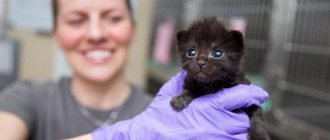Performing the procedure to remove reproductive organs in cats is not particularly difficult for a specialist. In order to minimize the risks of possible complications and pathological conditions in the animal after surgery, it is necessary to properly prepare the cat for sterilization. The main points that the pet owner must carry out independently are timely vaccination and antiparasitic treatment (destruction of ectoparasites and worms). It is also important to keep the animal on a fasting diet for at least 12 hours before surgery.
What to do: preparation for surgery
As you already understand, you need to prepare for the procedure. This must be approached with full responsibility. If you properly prepare your cat for the upcoming operation, then after emerging from anesthesia, the animal will feel good.
So, only a completely healthy pet can be sterilized. And to find out if your cat is healthy, you will have to undergo some tests.
Important!
It is necessary to visit a veterinarian before surgery. He will definitely examine the animal and prescribe the necessary tests.
Analyzes
At the veterinary clinic you will definitely have to take:
- Analysis of urine,
- blood test (biochemical and general);
- smear to identify pathogenic microflora.
Reference!
Also, at the veterinary clinic, the cat will be weighed, and an ultrasound and ECHO will be performed.
Ultrasound of the heart
An ultrasound examination of the abdominal cavity is necessary in order to diagnose the condition of the reproductive system, digestive and urinary organs of the cat. Also, the following organs will be examined separately:
- liver;
- kidneys;
- pancreas;
- bladder;
- stomach;
- intestines.
ECHO
ECHO is a study of the heart muscle using ultrasound. The procedure is absolutely safe for the animal. Thanks to it, you can check the condition of the cat’s heart and identify any pathologies and recognize signs of an existing disease.
Prepare the cat inside: anthelmintic. Tablet options
10 days before the upcoming operation, it is necessary to prevent helminth infection.
We present a list of the best drugs. Febtal is an anthelmintic drug. Dosage form: tablets. The tablets have no side effects. Prescribe one tablet per one and a half kilograms of animal weight. Average price: 105 rub.
Drontal are tablets intended for oral use. Refers to anthelmintic drugs. Used for the treatment and prevention of worms in cats. Prescribed: 1 tablet per 4 kg of body weight. Average price: 326 rub.
Kanikvantel - tablets to combat worms, trematodes, cestodes and nematodes. Price: from 320 to 450 rub.
Reference!
All medications presented should be given to the animal along with food; it is best to crumble and mix with food.
Recommended vaccinations
Important!
If the cat is healthy and surgery is to take place, then a month before it you need to get vaccinated.
The animal must be vaccinated so as not to become infected with dangerous diseases and serious
infections. Before the operation, veterinarians recommend a comprehensive vaccination that will protect the animal from many diseases, some of which are (and may be accompanied by such a simple symptom as sneezing):
- plague;
- chlamydia;
- herpesvirus;
- calicivirus;
- rabies.
Is it possible without them?
If you do not want to vaccinate an animal, then you must understand that any surgical intervention on the animal’s body will certainly reduce its immunity.
Therefore, before the operation, veterinarians will definitely introduce serum into the animal’s body, which will develop immunity for up to 14 days. Because of this, the price of sterilization will increase slightly, but the life of the animal is more important!
What does the veterinarian check before sterilization?
Before sterilization, a veterinarian must perform an examination, including measurements of body temperature, body weight, respiration and pulse. It is also necessary to conduct a general blood test and biochemistry for the animal. This allows for timely detection of possible pathological conditions of the body that do not manifest characteristic symptoms. A biochemical blood test will allow you to assess the state of the immune system, identify inflammatory processes and other abnormalities.
Echocardiography is also important, especially if the animal is elderly, and also if it has a history of chronic diseases. Ultrasound examinations of the liver and kidneys are prescribed to check for violations of their functional characteristics. In addition to an ultrasound examination of the heart, the veterinarian may prescribe additional diagnostics in cases where the animal was street and brought to the clinic. In such cases, it is necessary not only to diagnose internal systemic diseases, but also to identify infectious diseases - panleukopenia, leukemia virus and immunodeficiency.
Examinations by a veterinarian are carried out 2-5 days before planned sterilization. The owner of the animal must take the preparation before sterilization with the utmost responsibility. This will reduce the risk of postoperative complications and other negative consequences.
What should you not do the day before? Basic Rules
Preparing the cat for surgery begins 24 hours in advance. The veterinarian will tell you in detail what and how to do at this time. The main recommendations of doctors will be:
- Trim the claws to prevent the cat from injuring itself after surgery.
- Adhere to a proper diet.
- Avoid stress.
Is it possible to feed? In no case!
We stop feeding at least 12 hours before surgery. This is necessary so that the animal does not vomit while under anesthesia and when emerging from it.
What about drinking water?
Drinking water is not allowed 5 hours before surgery. It is imperative to ensure that the cat does not have access to water during this time.
Carrying out antihelminthic measures
Any qualified veterinarian will tell you that it is necessary to remove worms before neutering. Such treatment is desirable every 3 months; for pets that eat dry food and do not go outside, intervals of up to 4 months are possible. Removal of skin parasites (ticks, lice, etc.) is usually carried out as necessary.
When you plan to sterilize, you need to carry out deworming treatment approximately 10-12 days in advance. However, if you did this no more than a month ago, you can skip this step - re-application of the anthelmintic is not required.
Veterinarian advice
The best time for the procedure is early morning.
It is recommended to perform the operation at this time so that when recovering from anesthesia the cat is not left to its own devices. During the day you will have to monitor the condition of the pet and stay close to it. When heading to the veterinary clinic, make sure you have the correct carrier. Best of all, with a removable top. This is necessary in order to move the animal as little as possible after the operation. You will also need a blanket or bandage after sterilization.
It is recommended to place an absorbent diaper on the bottom of the carrier or basket. Animals perceive anesthesia differently and may involuntarily wet themselves under its influence. Also, the diaper will absorb discharge from the postoperative wound, if any.
Veterinarians say that the best age for sterilization is 8-10 months. At this time, the cat’s body is fully formed and mature. The main thing is that the operation is performed before the first signs of puberty appear.
Surgery in adult cats helps prevent cancer. Therefore, if sterilization was not carried out on time, this is not a reason to completely abandon it. The main condition is that the pet must be healthy.
Pros and cons of a sterilized cat
An adult unsterilized cat, deprived of mating with a male cat, often develops health problems, which leads to her short life. The decision to sterilize a pet will please owners with a number of positive aspects and reduce the risks of inflammatory diseases of the reproductive organs. Advantages of the operation:
- life expectancy will increase;
- good health will be maintained;
- the cat will stop bothering the owner with instincts that regularly wake up in the spring;
- lack of offspring that need to be accommodated;
- the cat stops marking its territory, emitting unpleasant odors.
In addition to the positive aspects, it is worth mentioning the disadvantages of the procedure:
- the appearance of seams on the animal’s body;
- the cat requires special care after surgery;
- increased appetite may arise;
- in rare cases, a hernia may develop.
© shutterstock
Postoperative care
Constant attention for two days (during this time the cat will fully recover from anesthesia).
Important!
If your pet has a very difficult time with the post-operative period, does not recover from anesthesia for a long time, or has foam at the mouth, then you should definitely consult a doctor!
After the clinic, the cat needs to be laid on the floor (so that it does not fall from a height) on something soft, with a diaper laid on top and covered from above.
The animal should be placed on the right side so as not to create additional stress on the heart. If a sleeping cat's eyes are open, then they need to be closed approximately twice an hour so that the cornea does not dry out.
If vomiting begins, you need to turn the muzzle on its side so that the animal does not choke.
After 3-4 hours you can offer the animal water, and after 12 - food.
It is recommended to remove the litter from the tray for several days to prevent it from getting into the wound. Otherwise, you need to completely follow the doctor’s recommendations; you may have to treat the suture site, give the animal any medications, or even give injections.
Types of cat sterilization
There are different ways to stop reproductive function and remove the organs that are responsible for it. The following are usually used:
- Ovariectomy - in this case, the uterus is not affected in any way, only the ovaries are removed. The method is suitable for young and unborn cats
- Hysterectomy - on the contrary, the uterus is removed, but the ovaries are preserved. Estrus and corresponding behavior will remain after this operation, so it is performed relatively rarely, only in special cases, if there are medical indications.
- Ovariohysterectomy – This operation removes both the uterus and ovaries. It is carried out for adult and postpartum cats, as well as for pathological changes in the uterus.
The methods of performing the surgical procedure can also be different:
- incision on the abdomen along the white line;
- side cut;
- ultra-small incision - a surgical hook is used for it;
- laparoscopy – endoscopic equipment is used to perform removal through punctures.
Which of these options is preferable is determined by the veterinarian depending on the characteristics of the pet’s body, as well as on what operation is chosen.
Another method stands a little apart - tubal occlusion. During this operation, the fallopian tubes are tied, but the reproductive organs are not removed. The cat still goes into heat and behaves the same as before, but she is no longer able to become pregnant. There is a risk associated with this operation - tumors and cysts may form in the ovaries and uterus.
Sterilization can also be chemical, but it is temporary. If this option is chosen, no surgery is performed; instead, the animal is given a drug that reduces hormone production so that sexual activity is suppressed. Chemical sterilization is used in cases where offspring are required from a cat, but not in the near future.
Feeding after sterilization
It is not recommended to feed the cat on the first day. You can drink it after 3 hours. The animal may refuse to drink. To moisten the oral mucosa, you can give a drop of water into your mouth using a pipette or a teaspoon. When recovering from anesthesia, the animal becomes nauseous and may vomit. According to the recommendations of a specialist, this is a common occurrence in a state of recovery from anesthesia. But there should not be more than 3 gag reflexes in the first hours. If vomiting does not stop, immediately return to the clinic.
Observing the owner's use of the toilet is one of the doctor's recommendations. After surgery, the cat must go to the toilet. Otherwise, a visit to the clinic is required.
For any deviation from the norm in your pet's behavior, consult your veterinarian. And if necessary, contact the clinic immediately.
Indications and contraindications for sterilization
In addition to the fact that sterilization of a cat is carried out due to the desire of the owner, the operation can have a therapeutic purpose and be planned or emergency. Among the indications:
- neoplasms in the reproductive organs;
- inflammatory processes;
- changes in the mammary glands caused by hormones;
- poorly performed earlier sterilization;
- prevention of various diseases (tumors, cysts, purulent processes, and so on).
Sterilization is not carried out if the cat has:
- age less than 6 months or older than 10 years;
- CVS pathologies were identified;
- estrus;
- pregnancy;
- inflammatory processes in the body and some other disorders.
Such contraindications to surgery relate mainly to cases of normalization of the cat’s behavior and elimination of the sexual instinct. If we are talking about preserving the life of an animal (for example, during an abnormally developing pregnancy), then sterilization becomes justified.
Tests and vaccinations before sterilization
It doesn’t matter whether you take your cat for sterilization or not, vaccination is always necessary. Regardless of the conditions for sterilizing a cat, if vaccination has not been carried out, the animal runs the risk of contracting many dangerous infections that can greatly weaken it. To prevent this from happening, you need to take care of vaccinating your pet at a young age.
But it happens that the owners skipped this stage and learned about the need for vaccination immediately at the time of preparing the cat for the sterilization operation. In this case, you need to immediately vaccinate the cat, and postpone the operation for a month - at least 30 days must pass between vaccinations.
If you do not want to vaccinate your cat under any pretext, your veterinarian will advise you to give it an injection that will develop immunity for 14 days. This precaution significantly increases the cost of the operation, but allows you not to be afraid of infection of your pet when the immune system is weakened after the operation.
Possibility of complications
Despite the simplicity of the surgical intervention, removal of reproductive organs can lead to certain complications. For example, a neutered cat will often develop a lump in the abdominal area. It occurs due to swelling of the soft tissues, as well as the division of new cells that are necessary to heal the wound. Such a lump in a cat after sterilization is not considered dangerous and will resolve over time. But if the neoplasm appears as a hernia in the internal tissues after the cat is sterilized through a suture, then emergency surgery will be needed. Other possible complications include:
- allergies to drugs;
- deterioration of kidney or liver function after anesthesia;
- cardiovascular dysfunction;
- bleeding.
The development of such complications may depend both on the quality of the operation and on its method. This is also affected by age, health status at the time of the intervention and postoperative care of the sterilized cat.
Surgical intervention in the female body is aimed at preventing reproductive functions. There are different types and methods of performing the procedure. Before the operation, examinations, tests, and examination of the patient are prescribed. In case of proper postoperative care, the pet does not experience complications, and its character, behavior and health improve significantly.
The article is for informational purposes only. Contact your veterinarian!
Do you like the article? 177
Who is contraindicated for sterilization?
Any procedure has contraindications. And before preparing a cat for sterilization, you need to talk to a veterinarian and undergo an examination.
Absolute contraindications to sterilization include:
- Kidney or heart problems.
- Individual response to sedation drugs.
Temporary contraindications , after elimination of which the operation can be performed, include:
- Estrus (sexual heat). Lasts up to 10 days.
- The presence of various diseases in the animal.
- Any other reasons that your veterinarian deems important to keep your pet healthy.
Up
At what age are cats spayed?
The ideal age for sterilization in cats is a relative concept. The operation can be performed at almost any age; from 6 months to 10 years it is tolerated quite easily. Older individuals may have contraindications or complications. Today, many veterinarians recommend carrying out the procedure up to a year or after the first heat. At a young age, the animal tolerates all manipulations easily and quickly adapts to the new state. He has not yet formed stable habits, which can be stronger than hormones. For example, an adult that is accustomed to marking its territory will likely continue to do so after spaying or neutering. Therefore, it is wise to act on warning and form the pet’s character and habits from a young age. It is believed that by 8 months a cat reaches sexual maturity and can bear and bear offspring up to 4 times a year. But, firstly, this is individual, for some individuals this moment comes earlier, for others later, and secondly, there are breeds in which the offspring grow for a long time and mature only by one and a half to two years. It is too early to sterilize such cats at 8 months, and it is better to select the timing of the operation together with a veterinarian. In general, the bulk of procedures occur between the ages of one and three years.











